Three Suspicious Lesions on an Elderly Woman's Face
An 82-year-old woman presents for evaluation of an ear lesion--and receives a complete skin exam. Can you identify the 3 other lesions found?
Figure 1.
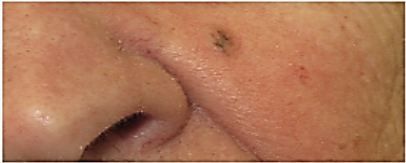
Figure 2.
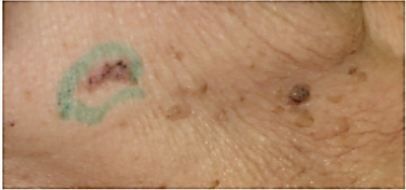
Figure 3.

Figure 4.
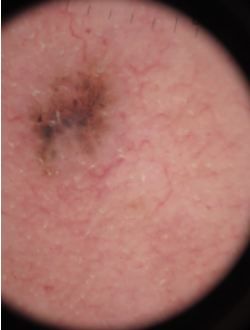
Figure 5.
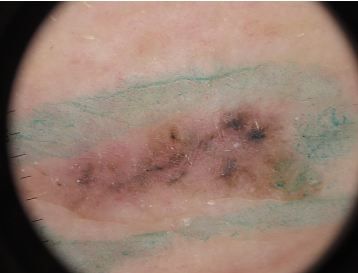
Figure 6.
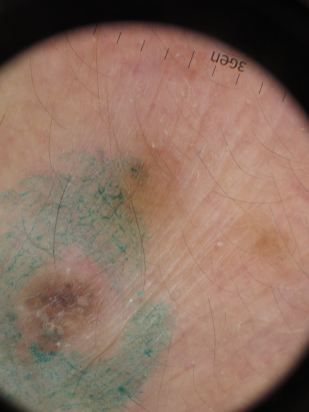
Part 3: Non-melanoma Skin Cacer - A Primer for Primary Care
An 82-year-old woman presents to your office for evaluation of a growth on her right ear. She has marked photo damage, hazel eyes, no history of skin cancer, sunburns, or tanning booth use. You incidentally note on her left medial cheek a 5-mm pigmented nodule (Figure 1; click to enlarge ). Finding this lesion atypical, you convince the patient to change into a gown for a complete exam. On the right neck there is a 1.5-cm linear pigmented lesion (Figure 2, click to enlarge) and above the left lateral temporal brow there is an irregularly pigmented 4-mm brown papule (Figure 3, click to enlarge).
What is the most likely diagnosis for all three lesions?
A. Seborrheic keratosis
B. Squamous cell carcinoma
C. Pigmented basal cell carcinoma
D. Melanoma
E. Pigmented actinic keratosis
F. Blue nevi
Please click "next" for answer and discussion
Answer: C. Pigmented basal cell carcinoma
Discussion
Basal cell carcinoma (BCC) is the most common form of skin cancer and is characterized by slow growing and locally destructive behavior.1 It usually develops in sun-exposed areas especially on the face. Unlike other types of BCC, pigmented BCC (PBCC) is more common in patients with darker complexion and dark brown eyes such as black, Hispanic, and Asian populations.2,3 Most BCCs are not pigmented, but variable amounts of melanin may be present.4 PBCC can appear brown or black-blue in a background and context not unlike that described for ordinary BCCs in the previous case. Thus, PBCCs present as pigmented lesions often with accompanying translucency, rolled border, or surface ulceration.2,4
While PBCCs are more common in darker skin, BCCs with partial pigment and even completely pigmented lesions can occur in fair skin, similar to the patient in the current case.
Dermoscopy is used by dermatologists to distinguish benign from malignant lesions and can help make a clinical diagnosis of PBCC. Dermoscopic criteria for PBCC include multiple blue-gray dots/globules, in-focus dots, maple leaf-like areas, spoke wheel areas, concentric structures, and blue-gray ovoid nests.5 The three PBCCs shown in Figures 1-3 have many of these features, as evident in the dermoscopic views of each: Figure 4, left medial cheek; Figure 5, right neck; Figure 6, left lateral temporal brow. (Please click on each image to enlarge.)
As with other BCCs, biopsy and histopathologic examination of PBCC are indicated to confirm the diagnosis and rule out other causes of pigmented lesions including melanoma.6 Treatment of PBCC is the same as that for other subtypes of BCC and multiple treatment modalities are available including Moh’s micrographic surgery, simple excision, electrodessication and curettage, cryosurgery, and topical therapy.
This patient opted for MMS for the lesions on the cheek and brow and curettage and electrodessication for neck BCC.
References:
1. Linares MA, Zakaria A, Nizran P. Skin Cancer. Prim Care. 2015;42:645-659.
2. Coleman CI, Wine-Lee L, James WD. Pigmented basal cell carcinoma: uncommon presentation in blue-eyed patients. JAMA dermatology. 2013;149:995-996.
3. Bigler C, Feldman J, Hall E, Padilla RS. Pigmented basal cell carcinoma in Hispanics. J Amer Acad Dermatol. 1996;34:751-752.
4. Bolognia J, Jorizzo JL, Schaffer JV. Dermatology. [Philadelphia]: Elsevier Saunders; 2012.
5. Russo T, Piccolo V, Lallas A, Argenziano G. Recent advances in dermoscopy. F1000Research. 2016;5.
6. Gandhi SA, Kampp J. Skin cacner epidemiology, detection, and management. Med Clin North Am. 2015;991323-1335.